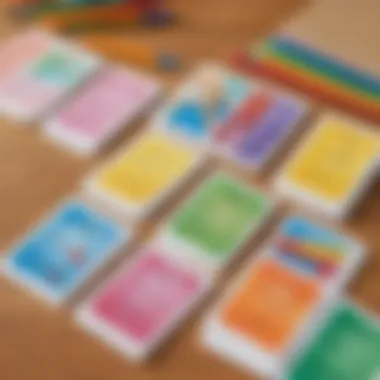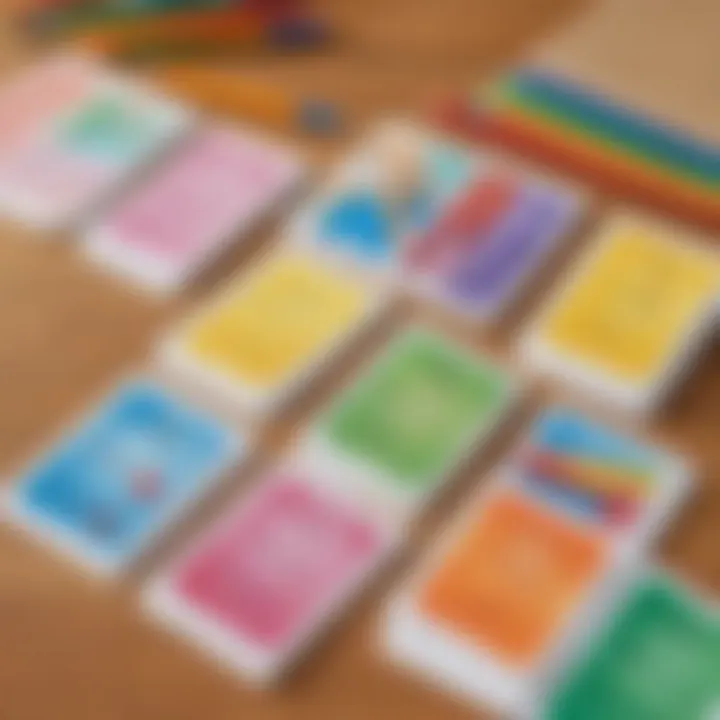Engaging Grammar Games for Elementary Students


Intro
Teaching grammar to elementary students can be a daunting task. This age group thrives on activities that capture their interest and enable active participation. Innovative games provide an avenue for transforming traditional grammar lessons into engaging experiences. Through interactive methods, students may gain a deeper understanding of grammar and its nuances, enhancing both their skills and confidence.
This article aims to unpack various games tailored to teach grammatical concepts effectively. By bringing fun into language learning, educators can inspire young minds while making complex grammatical rules approachable.
Creative Activities
Engaging students through creative activities is a powerful means to teach grammar. It allows children to express themselves while reinforcing essential linguistic skills.
Craft Ideas
When designing creative activities, aim for simple crafts that align with grammar topics. Here are some engaging ideas:
- Grammar clocks: Students make clocks to show parts of speech, placing verbs, nouns, and adjectives in corresponding areas.
- Sentence strips: Children can create sentence strips using construction paper, allowing them to physically manipulate words to construct sentences.
Step-by-Step Guides
For each craft, clear instructions are crucial. For instance, in the Grammar Clocks activity, start with:
- Gather materials such as paper plates, markers, and scissors.
- Divide the paper plate into segments for each part of speech.
- Each student identifies a ten words for each part of speech, and attaches them to the appropriate section on the clock.
- Discuss these words together, reinforcing the concept.
Educational Value
These crafts foster an interactive environment where students gain hands-on experience with grammar. They not only enjoy the process but also develop a practical understanding of how grammar structures operate within sentences.
Fun Quizzes
Quizzes can be a captivating way to test comprehension while keeping students engaged.
Quiz Topics
Several topics may be covered, such as:
- Parts of speech
- Verb tenses
- Punctuation rules
Question Types
In addition, diverse question types offer variety. Engaging formats may include:
- Multiple-choice
- Fill-in-the-blank
- Matching exercises
Knowledge Reinforcement
By incorporating quizzes into lessons, students have the opportunity to reinforce their learning. Regular assessments can help track progress while making the learning process enjoyable.
Fact-Based Articles
Providing access to fact-based articles can assist in expanding vocabulary and understanding of grammar contexts.
Topics
Topics often include grammar usage in various forms, such as:
- Importance of proper punctuation
- Different writing styles
- Creative applications of grammar in storytelling
Engaging Content


Content should be presented clearly, breaking down complex ideas into easily digestible segments for elementary readers. Keeping it relevant may facilitate better retention of facts and concepts.
Prolusion to Grammar Games
Games play an essential role in teaching grammar to elementary students. They transform the learning process by making it engaging and interactive. Using games in grammar education provides numerous benefits. These include reinforcing grammatical concepts, catering to diverse learning styles, and creating a positive classroom environment. It allows students to practice their language skills in a fun setting, enhancing their motivation to learn.
Understanding Grammar's Role in Language Skills
Grammar is fundamental for language development. It helps children construct sentences correctly, convey clear messages, and listen effectively. A strong grasp of grammar supports reading comprehension and writing skills. When students understand how words fit together, they can communicate ideas more clearly.
Teaching grammar through games connects theoretical concepts to practical applications. Activities like quizzes and role-playing enable students to see real-life language use. Games make grammar intuitive. Instead of memorizing rules, students can learn through context and examples, leading to deeper understanding.
Importance of Engagement in Learning
Engagement is key to effective learning, especially for young learners. Traditional teaching methods often leave students uninspired. Integrating games into the learning experience increases their attention span and enthusiasm.
Studies show high engagement leads to better retention of information. In grammar education, interactive activities hold students’ interest. Through games, learners can practice grammar rules and receive immediate feedback. This swift feedback loop keeps students informed on their progress.
Engagement through play encourages students to take risks in learning, which is essential for mastery.
Effective grammar games also promote social interaction. Students often collaborate, share insights, and learn from peers. Measures such as teamwork can make learning grammar a community effort, thus reinforcing knowledge and encouraging social connections.
By considering the benefits of grammar games and implementing them skillfully, teachers can elevate the language skills of their elementary students significantly.
Types of Grammar Games
Understanding the types of grammar games available is fundamental. These games can change how grammatical concepts are taught and understood by elementary students. The effectiveness of a game often depends on its ability to engage students actively. Each type comes with unique features that cater to various learning strategies and preferences.
Interactive Digital Games
Interactive digital games are a growing trend in grammar education. These games utilize technology in innovative ways to engage students. Unlike traditional methods, digital formats provide instant feedback, allowing students to learn from mistakes immediately. This approach hits various learning styles. Students who are more visual can benefit immensely from colorful graphics and animations.
Moreover, access to metrics can help educators understand which areas students struggle with. When integrating digital games into lessons, it is crucial to choose age-appropriate content to maintain students' interest. Examples incld websites like ABCMouse or PBS Kids.
Board Games for Grammar Practice
Board games provide a tactile approach to grammar learning. Formats such as Scrabble have a long-standing role in enhancing word usage skills. Games can be specifically designed to focus on specific grammar areas, such as sentence structure or parts of speech. One benefit is the social interaction involved, encouraging teamwork and communication as students play together.
Educators should tailor the complexity of the game based on the class's skill level. Additionally, physical movement during gameplay can enhance retention of concepts learned, keeping students engaged throughout the session. Popular board games include Mad Libs and Grammar Police.
Card Games as a Learning Tool
Card games are versatile and easy to adapt to various grammar topics. A simple example is creating a customized deck of cards, where each card features a different type of noun, verb, or adjective. Players can take turns forming sentences with the drawn cards. This not only familiarizes students with grammatical structures but also with vocabulary.
Using card games allows for strategic thinking as well. Students must decide how to play their cards effectively, which integrates critical thinking into grammar learning. This format works well in pairs or small groups, fostering interaction among peers.
Role-Playing Activities
Role-playing activities immerse students in real-world scenarios. They can practice grammar in context by acting out stories or dialogues. This method enhances both their speaking and listening skills while reinforcing the grammatical rules naturally. For example, assigning characters that align with specific parts of speech can solidify understanding through practical use.
Such activities open a space for creativity. Students can express themselves as they immerse in various roles and situations. However, planning is essential. Teachers may need to provide guidelines to keep students focused on grammar objectives. Engaging dynamic situations can foster their grammatical learning effectively.
Engaging students actively, through different game types, enhances the learning experience significantly. By diversifying the activities, teachers can cater to a broad spectrum of learning preferences while making grammar a less daunting subject.
Benefits of Using Games in Grammar Instruction
The incorporation of games in grammar instruction provides numerous advantages that significantly enhance the learning experience for elementary students. By employing a gaming approach, educators can make abstract grammatical concepts more tangible. This shift in convention transforms the perception of grammar learning, making it less of a chore and more akin to enjoyable exploration. Specific elements that highlight this topic as essential include improved retention of grammar concepts, fostering collaborative learning, and establishing critical thinking skills among young learners.
Enhancing Retention of Grammar Concepts


One major advantage of implementing games in grammar teaching lies in the enhanced retention of learned concepts. Engaging interactions and the fun aspects of gameplay promote memory retention and understanding. Students often remember lessons better when they are not merely discussed in traditional formats. Instead of rote memorization, they experience grammar through practical use.
Studies show that students are more likely to recall information that they have encountered in a playful manner compared to standard methods. Thus, when children explore parts of speech through playful activities, like a joyful scavenger hunt, they connect the dots between grammar rules and real-world use. Playing games which incorporate grammar elements requires students to actively use their knowledge, anchoring these concepts in memory.
Encouraging Collaborative Learning
Games often rely on students working together. This teamwork offers a dual advantage: students are motivated to participate, and they learn from each other’s strengths. When children engage in grammar games, they discuss strategies and share knowledge about grammar rules. Performing in groups not only engages students but also inspires social skills. Team-based activities foster peer communication and build confidence.
“In collaborative environments, children can feel less pressure, allowing for deeper learning.”
While competing or collaborating in tasks, students learn not only grammar but also how to work wisely with others. Rather than focusing solely on winning, most grammar games emphasize collective success, making learning an inclusive and shared responsibility.
Fostering Critical Thinking Skills
The synthesis playing offers also nurtures critical thinking. Many educational games require students to analyze situations, make decisions, and solve problems. By navigating grammar challenges creatively, students activate their problem-solving capacities in real-time. Input, reflection, and evaluation emerge as students confront varying crises within a game scenario.
While playing, learners can engage more complex thought processes compared to conventional lessons. They must understand when to apply different grammatical principles according to gaming context. This stimulates a deeper awareness of language uses in various instances. Resulting from gameplay, kids develop versatility in using grammar that only a conventional approach fails to teach adequately.
Best Practices for Implementing Grammar Games
Implementing grammar games effectively requires thoughtful consideration and strategic planning. Educators need to focus on certain practices to ensure these interactive activities instill the essential grammar skills in elementary students. Selecting the right games, integrating them properly into lesson plans, and assessing their impact are all crucial in transforming literature lessons from theoretical studies into hands-on experiences that encourage learning.
Choosing Appropriate Games for Age Groups
An important first step is to choose games that resonate with the specific age group. Children at different ages have varying cognitive abilities and interests. For instance, young learners may enjoy simple board games focused on basic vocabulary and sentence structure. As students age and gain more advanced grammatical knowledge, educators may opt for more complex digital games that, for example, involve interactive story-building.
Not all games suit every experience level. It is key to match a grammar game with students' understanding of grammar. This way, students remain engaged without feeling overwhelmed or bored. Teachers can implement a selection of games and include students in the decision-making process, shaping lessons that reflect their interests while guiding learning objectives. Here are some factors to consider:
- Developmental Stage: Adolescent students can handle abstract concepts, while younger children thrive on tangible materials.
- Focus on Concepts: Games emphasizing specific grammer areas like nouns or verbs may cater better to varying comprehension levels.
- Group Dynamics: Some age groups respond well to group games promoting social interaction. Others may prefer solo challenges.
Integrating Games into Lesson Plans
Smoothly integrating grammar games into lesson plans maximizes their benefits. Teachers must evaluate where games fit best within the curriculum and how to blend them harmoniously. For successful integration, grammar games should align with educational objectives and sequences planned for broader lessons.
One effective approach is to start the class with a brief review of the grammar topic, using clear examples to illustrate key points. Afterwards, introducing a related game follows the initial instruction, putting theory into practice. This strategy allows students to apply new knowledge immediately. Educators might also consider the following methods:
- Structured Time: Dedicate part of the class specifically for game activities, ensuring it is valued time rather than just filler.
- Thematic Cohesion: Link the game to the overall lesson theme to reinforce connections in students' minds.
- Feedback Mechanisms: Throughout the game, prompt students to verbalize their thought processes, encouraging metacognitive awareness and reflection.
Assessing Game Effectiveness
Finally, assessing the effectiveness of grammar games is essential in determining success. Teachers should implement various evaluation strategies to gauge students’ comprehension and retention. Resume regular assessment leads to a tailored approach, ensuring optimum learning experiences and results for individual students.
There are several methods for evaluating the impact:
- Observation: Monitor engagement and interactions during the games. Focus on how students apply grammar concepts while executing game tasks.
- Follow-Up Quizzes: Conduct assessment quizzes or practice exercises after gameplay, especially focused on the grammatical concepts practiced.
- Student Feedback: Solicit direct feedback from students on their experiences. Encourage reflections on what worked and what they enjoyed or disliked about the activities.
By following these best practices, educators can implement grammar games in a way that optimizes learning outcomes. This approach helps nurture a more comprehensive grasp of grammar concepts while making the journey enjoyable for the students.
Examples of Effective Grammar Games
Games are not just fun activities. They are powerful tools for teaching grammar concepts. Effective grammar games engage students while they practice essential language skills. These activities help reinforce lessons and encourage proper usage of grammar in a primary way. They also prompt collaboration among students and promote active participation, leading to a more interesting learning environment.
Adjective Scavenger Hunt
Adjective Scavenger Hunt is a creative way for students to learn about adjectives. This game encourages participating students to explore their environment. A teacher will prepare a list of specific adjectives before the game. During the scavenger hunt, students must find objects that match the adjectives on their list.
Using descriptive language, students may, for instance, find a
Challenges and Considerations


In any teaching method, certain challenges arise which must be addressed to ensure effective learning. Grammar games offer unique advantages but also present specific considerations that must strike a balance potential benefits. This section examines these concerns, from acknowledging diverse learning styles in young children to effectively managing distraction within gameplay activities. Understanding these challenges helps educators ensure they implement approaches that truly help students flourish.
Addressing Different Learning Styles
Students engage with material in various ways. Some learners are visual, while others excel in auditory or kinesthetic settings. Understanding these different styles is essential for developing interactive games that cater to all needs. When designing grammar games, educators can include visuals like charts for visual learners or interactive elements—such as movement or hands-on tasks for those who lean towards kinesthetic learning.
Strategies to accommodate different learning styles include:
- Incorporating images and graphics, making visuals experience more engaging.
- Using music or rhythm in vocabulary games to strengthen memorization for auditory learners.
- Including role-play or physical positioning in language games to appeal to kinesthetic learners.
By embracing varied approaches, learning experiences become richer and more accessible to each student's pathway.
Managing Game-Related Distractions
Once games are introduced into learning environments, avoiding distractions becomes crucial. Games can facilitate fun and engagement, but sometimes, attention can drift away from academic goals. Establishing ground rules at the start is critical. Moreover, it's vital to maintain coinsistent expectations about behavior during activities. Games can lapse into chaotic moments, especially in enthusiastic children, which can dilute educational impact. To counter these distractions, educators should:
- Establish clear objectives for every game session so that students understand the learning intended.
- Maintain focused time limits for each game. This way, attention remains engaged.
- Encourage quick debriefs after every gaming session, discussing what students learned relevant to grammar.
- Observe and adjust during gameplay to realign focus among students when distractions arise.
Having strategies like these in place can help create a well-managed learning environment.
Evaluating Student Progress
Assessment in educational settings should follow a trajectory that supports sustained progress. With grammar games, it should not end merely with completion, but instead integrate evaluations throughout the process. Thus, observing how games contribute to grammar mastery is essential. Educators should use both formal and informal assessment methods to gauge student performance—like compiling scores from games played or noticing effective application of learned concepts in different scenarios.
Some evaluation suggestions include:
- Collecting assessments: Use rubrics to formally evaluate participation and performance during gameplay.
- Monitoring spelling or communication improvements in real-time encourages further contemplation of the subject.
- Seeking peer feedback aids in refining areas of improvement, reinforcing collaboration.
With intentional observation and reflection instilled from the start, progress evaluation can positively impact literacy outcomes. Understanding these challenges can enhance the overall effectiveness of grammar games, leading to rich educational experiences for elementary students.
Future Trends in Educational Games for Grammar
Educational games are evolving, driven by advances in technology and shifts in teaching methodologies. This transformation is particularly relevant in teaching grammar to elementary students. With an increased focus on interactive learning, the future trends in educational grammar games play a vital role in language acquisition. Understanding these trends helps educators stay updated with innovative methods that could enhance their teaching effectiveness.
The Role of Technology in Game Development
Technology is at the forefront of developing new educational games. Interactive platforms leverage multimedia elements like sound, video, and animations to create engaging experiences. Games designed for mobile devices or tablets allow for novel frameworks where students can explore grammatical concepts through interactive content rather than static drills.
To illustrate, apps like Grammarly for Kids focus on ensuring gamified learning experiences. They offer linguistic challenges that adapt to the student's proficiency level. Such adaptive games reimagine traditional learning, providing real-time feedback that helps learners understand their mistakes and correct them without frustration. This focus on technology opens the door for many benefits, like individualized learning paths, which can accommodate the varying skill levels in a classroom. Incorporating technology in education helps broaden accessibility as well, continuing to remove barriers that may hinder some learners.
Emerging Game Formats and Formats
The future trends also include the emergence of various game formats. These formats not only include traditional board or card games but also introduce augmented reality (AR) and virtual reality (VR) components. Gains like AR Word Explorers allow learners to immerse themselves in three-dimensional environments to identify nouns or creating their own story problems by solving puzzled scenarios.
Moreover, modular and customizable game designs are becoming popular. Educators can alter rules and enhance the scenarios to better suit their curriculum needs – customizing experiences ensures relevance in a diversity of contexts. These innovations bridge fun and education by engaging students and motivating them to learn grammar concepts effectively.
The grammatical proficiency of students can be significantly enhanced through the effective utilization of emerging game trends, ensuring they gain crucial language skills even in a playful context.
End
In this section, we summarize the essential aspects discussed throughout the article on integrating games into grammar education for elementary students. The benefits of using interactive games in teaching grammar cannot be overstated. They not only make learning enjoyable but also significantly enhance the understanding of grammatical concepts. Through gameplay, students can practice their grammar skills in a supportive environment. Engaging in these activities helps solidify retention and application of language rules.
Summing Up the Value of Games in Grammar Teaching
Firstly, let’s acknowledge the diverse benefits games provide. They serve as an effective tool in enhancing retention of grammar concepts. Traditional lecture-based instructions often lead to disengagement. In contrast, games create a lively atmosphere, allowing close involvement from all students. When children engage in play, they process information actively, which is shown to improve learning outcomes.
Additionally, educational games foster collaborative learning. As students work together to achieve goals, they develop social and communication skills. They learn to negotiate, strategize, and resolve conflicts within small groups. Such interactions lay the groundwork for broader critical thinking skills important both academically and in everyday life.
Moreover, the integration of technology in game development has amplified the instructional impact of grammar lessons. Students can now engage with comprehensive digital platforms that make assessments not only possible but easier as well. This opportunity gives teachers valuable insights into student progress and areas that may require focused instruction.
To conclude, the use of games in teaching grammar is a strategic and beneficial approach. They not only support the learning experience but also tailor instruction to meet various learners' needs. Embracing these innovations ensures effective language education while capturing the interest of students. Harnessing the potential of games can lead to cultivation of informed, confident future communicators.
"Educational games bridge the gap between learning and enjoyment, making them invaluable in modern teaching practices."
In sum, integrating grammar-related games can revolutionize teaching methods. By fostering engagement and enabling retention, educators can make a significant impact in the realm of language skills development.







